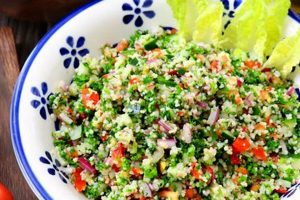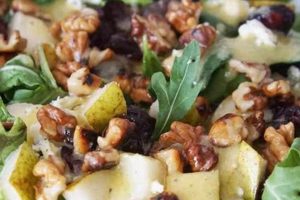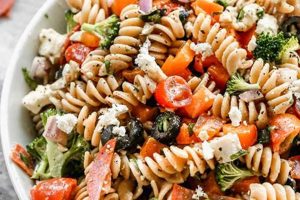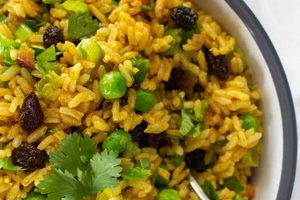A chilled pasta dish featuring ring-shaped pasta filled with meat or cheese, combined with vegetables, often including tomatoes, olives, and artichoke hearts, and dressed with a vinaigrette. Variations can incorporate cured meats like salami or prosciutto, and different cheeses such as mozzarella or provolone. A typical vinaigrette might feature olive oil, red wine vinegar, garlic, and Italian herbs.
This type of dish offers a refreshing and flavorful meal, suitable for warm weather or as a light yet satisfying option. Its versatility allows for customization to individual preferences, accommodating dietary restrictions or expanding flavor profiles with a wide array of ingredients. The blend of textures and flavors, from the soft pasta to the crisp vegetables and tangy dressing, creates a balanced and appealing culinary experience. Historically, pasta salads emerged as a convenient and portable food, gaining popularity as refrigeration became more accessible.
This exploration will further delve into variations on the dish, including specific ingredient recommendations, preparation techniques for both the pasta and the dressing, and tips for optimal presentation and storage.
Tips for a Superior Tortellini Salad
Achieving optimal flavor and texture requires attention to detail throughout the preparation process. The following tips offer guidance for creating a truly exceptional dish.
Tip 1: Cook the Pasta Al Dente: Slightly firm pasta holds its shape better in the salad and prevents a mushy texture. Follow package directions, reducing cooking time by a minute or two for optimal firmness.
Tip 2: Chill the Pasta Thoroughly: Rinsing the cooked pasta under cold water stops the cooking process and cools it quickly. Thoroughly chilled pasta absorbs the dressing more effectively, enhancing the overall flavor.
Tip 3: Use High-Quality Ingredients: Fresh, flavorful ingredients elevate the final product. Opt for ripe, in-season vegetables, high-quality cheese, and a robust olive oil.
Tip 4: Balance the Dressing: The vinaigrette should complement the other ingredients, not overpower them. Achieve balance by adjusting the ratio of oil to vinegar and seasoning with appropriate amounts of salt, pepper, and herbs.
Tip 5: Marinate the Salad Briefly: Allowing the salad to marinate for a short period, typically 30 minutes to an hour, allows the flavors to meld. Avoid over-marinating, as this can make the vegetables soggy.
Tip 6: Add Fresh Herbs: Fresh herbs, such as basil, oregano, or parsley, provide a bright, aromatic element. Add them just before serving for the best flavor and visual appeal.
Tip 7: Consider Textural Variety: Toasted pine nuts, sun-dried tomatoes, or crumbled bacon can add interesting textural contrasts.
By following these tips, one can create a dish that balances flavor, texture, and visual appeal, ensuring a satisfying culinary experience.
These guidelines provide a solid foundation for crafting a memorable tortellini salad. Experimentation with ingredients and flavors allows for personalized variations.
1. Fresh Tortellini (Cheese or Meat)
Fresh tortellini serves as the foundational element, significantly impacting the overall quality and flavor profile. Its texture and flavor influence the final result. Dried tortellini, while convenient, often lacks the delicate texture and nuanced flavor of its fresh counterpart. The filling, whether cheese or meat, contributes significantly to the overall taste experience. A ricotta-based filling offers a creamy, subtly sweet element, while a meat-filled tortellini provides a richer, savory dimension. This choice affects how the tortellini interacts with the other salad components, such as the vinaigrette and vegetables. For instance, a delicate cheese-filled tortellini pairs well with a light vinaigrette and fresh vegetables like peas and asparagus, while a heartier meat-filled variety complements a more robust dressing and ingredients like roasted peppers and olives.
The freshness of the tortellini directly correlates with the overall quality of the salad. Fresh pasta offers a softer, more palatable texture and a richer flavor that complements the other ingredients. Using fresh tortellini allows for better absorption of the vinaigrette, leading to a more flavorful and cohesive dish. Conversely, using dried tortellini can result in a firmer, less absorbent pasta that doesn’t integrate as well with the other salad components. Consider a scenario where two identical salads are prepared, one with fresh, cheese-filled tortellini and the other with dried. The salad with fresh tortellini will likely have a brighter, more nuanced flavor, while the dried version might taste blander and have a chewier texture.
Selecting fresh, high-quality tortellini is crucial for creating a successful dish. While dried tortellini offers convenience, fresh pasta elevates the sensory experience. This understanding allows for informed decisions regarding ingredient selection and preparation, ultimately contributing to a more satisfying culinary outcome. The choice between cheese or meat-filled tortellini allows for further customization, enabling one to tailor the salad to specific flavor preferences and dietary considerations. By prioritizing fresh tortellini, one ensures a superior foundation upon which to build a balanced and flavorful salad.
2. Vibrant Vegetables
Vibrant vegetables play a crucial role in an Italian tortellini salad, contributing not only to visual appeal but also to flavor, texture, and nutritional value. Their selection and preparation significantly influence the overall sensory experience and balance of the dish. The inherent freshness and color of the vegetables enhance the presentation, making the salad more inviting. Beyond aesthetics, vegetables provide essential nutrients and textural contrast, complementing the richness of the tortellini and the tang of the vinaigrette. Consider a salad with vibrant bell peppers, cherry tomatoes, and crisp cucumbers contrasted against the soft tortellini and creamy dressing. This combination offers a multi-sensory experience that engages sight, taste, and touch.
The choice of vegetables influences the flavor profile. Sweet bell peppers offer a subtle sweetness, while peppery arugula adds a bite. The inclusion of acidic vegetables like cherry tomatoes provides a tangy burst that balances the richness of other components. Proper preparation further enhances their contribution. Blanching vegetables like broccoli or asparagus preserves their vibrant color and crisp-tender texture. Roasting vegetables like bell peppers or zucchini intensifies their sweetness and imparts a smoky depth. For example, roasted red peppers can add a smoky sweetness that complements the savory notes of a meat-filled tortellini, while blanched asparagus provides a delicate, slightly bitter counterpoint to a creamy cheese-filled variety.
Selecting a variety of colorful vegetables ensures a balanced nutritional profile and a more complex flavor experience. Understanding the interplay between color, flavor, and texture allows for informed choices that elevate the final product. Challenges can arise when vegetables are not properly prepared or stored. Overcooked vegetables lose their vibrant color and become mushy, detracting from the overall appeal. Improper storage can lead to wilting or spoilage, compromising both the aesthetic and culinary quality of the salad. Prioritizing fresh, properly handled vegetables ensures the salad delivers both visual and gustatory satisfaction, contributing significantly to a well-rounded and enjoyable culinary creation.
3. Tangy Vinaigrette
The vinaigrette serves as a critical component, providing a counterpoint to the richness of the pasta and other ingredients. Its acidity brightens the overall flavor profile and helps to unify the diverse elements within the salad. A well-balanced vinaigrette elevates the dish from a simple combination of ingredients to a cohesive and flavorful experience. Its careful consideration is essential for a successful outcome.
- Acidity as a Balancing Element
The primary function of the vinaigrette’s acidity, derived from ingredients like vinegar or citrus juice, is to cut through the richness of the tortellini, cheese, and any potential cured meats. This balance prevents the salad from feeling heavy or overly rich. For example, a red wine vinaigrette provides a sharp acidity that complements the creamy texture of cheese-filled tortellini. The acidity also plays a role in preserving the vibrant colors of the vegetables and enhancing their flavors.
- Emulsification and Texture
A stable emulsion, where the oil and vinegar are properly combined, is crucial for a pleasant mouthfeel and even distribution of flavor. A poorly emulsified vinaigrette can leave the salad oily or watery. Emulsification is achieved through vigorous whisking or blending, which suspends tiny droplets of vinegar within the oil, creating a creamy consistency that coats the ingredients evenly. This even coating ensures that each bite delivers a balanced flavor profile.
- Flavor Combinations and Complementary Ingredients
The vinaigrette’s flavor profile should complement the other ingredients in the salad. Classic Italian flavors like garlic, oregano, and basil are common additions. Other options include Dijon mustard, lemon zest, or even a touch of honey for sweetness. For instance, a lemon vinaigrette with fresh dill might pair well with a seafood-inspired tortellini salad, while a balsamic vinaigrette with sun-dried tomatoes complements a more traditional Italian composition.
- Impact on Overall Palate and Culinary Experience
The vinaigrette ties all the ingredients together, creating a harmonious blend of flavors and textures. It provides the final layer of complexity, transforming individual components into a unified dish. A well-executed vinaigrette elevates the sensory experience, making the salad more refreshing and enjoyable. It ensures the dish is not just a collection of ingredients but a carefully crafted culinary creation. Conversely, a poorly balanced or improperly emulsified vinaigrette can detract from the overall experience.
The vinaigrette is not merely a dressing; it’s the element that harmonizes the flavors and textures within the salad. Its careful consideration ensures a balanced and enjoyable culinary experience. By understanding the role of acidity, emulsification, complementary flavors, and the overall impact on the palate, one can create a vinaigrette that elevates the Italian tortellini salad from simple to exceptional. The vinaigrette is the conductor of the flavor orchestra, bringing together the diverse instruments of the salad into a harmonious symphony.
4. High-Quality Cheese
High-quality cheese significantly impacts the sensory experience of an Italian tortellini salad. Cheese contributes salty, savory notes, creamy textures, and aromatic complexity, enhancing the overall flavor profile. Selection influences the balance and depth of the final dish. Fresh mozzarella, for example, offers a delicate, milky flavor and soft texture, complementing the fresh vegetables and vinaigrette. In contrast, aged provolone provides a sharper, more assertive taste and a firmer texture, adding a robust dimension to the salad.
The quality of the cheese directly correlates with the overall enjoyment of the salad. High-quality cheese, typically made with fresh, natural ingredients and careful aging processes, possesses a more nuanced and complex flavor profile compared to mass-produced alternatives. This depth of flavor elevates the salad, creating a more satisfying culinary experience. For instance, using a high-quality Parmesan, with its granular texture and nutty, savory notes, adds a layer of complexity that enhances the other ingredients. Conversely, using a pre-grated, lower-quality Parmesan might result in a blander, less satisfying salad. The distinction becomes particularly noticeable when tasting side-by-side comparisons.
Selecting high-quality cheese is an investment in the overall quality of the Italian tortellini salad. While cost considerations may influence choices, opting for superior cheese often yields a more rewarding result. This understanding allows for informed decisions when purchasing ingredients, leading to a more flavorful and enjoyable culinary experience. Furthermore, understanding the nuances of different cheese varietiestheir textures, flavors, and how they interact with other ingredientsallows for greater control over the final product, enabling the creation of a truly exceptional dish. The careful selection of cheese demonstrates an attention to detail that elevates the simple salad to a more refined and satisfying meal.
5. Optional Cured Meats
Cured meats, while optional, contribute a significant depth of flavor and satisfying saltiness to an Italian tortellini salad. Their inclusion introduces a savory complexity that complements the other ingredients, enhancing the overall culinary experience. The selection of cured meats influences the final flavor profile; salami provides a spicy, robust note, while prosciutto offers a more delicate, sweet-salty flavor. These additions create a more substantial and satisfying salad, transforming it from a light dish into a more complete meal. For example, adding crispy prosciutto to a tortellini salad with a light lemon vinaigrette and fresh vegetables creates a balanced interplay of textures and flavors. The saltiness of the prosciutto complements the brightness of the vinaigrette and the sweetness of the vegetables, resulting in a more complex and satisfying dish.
The choice and quantity of cured meats should be carefully considered. Overuse can overpower the more delicate flavors of the cheese and vegetables. A balanced approach ensures that the cured meats enhance the existing flavors without dominating the palate. Sliced, diced, or crumbled cured meats offer textural variation. Crisping pancetta or prosciutto before adding it to the salad introduces a contrasting crunchy element. This textural diversity further enhances the sensory experience. For instance, adding diced salami to a tortellini salad with a creamy dressing and soft vegetables provides a pleasant textural contrast, preventing the salad from becoming overly homogenous.
The judicious use of cured meats elevates the Italian tortellini salad by adding savory depth and textural complexity. Careful selection and portioning ensure these additions enhance rather than overwhelm the other components. Understanding the interplay of flavors and textures allows for informed decisions regarding the inclusion and preparation of cured meats, contributing to a more balanced and satisfying final product. Successfully incorporating cured meats demonstrates culinary finesse, transforming a simple pasta salad into a more sophisticated and flavorful dish.
6. Aromatic Herbs
Aromatic herbs provide a crucial dimension to Italian tortellini salad, elevating its flavor profile beyond the foundational ingredients. Careful selection and application of herbs contribute a nuanced complexity, transforming a simple pasta salad into a fragrant and flavorful experience. The choice of herbs significantly influences the overall character of the dish, allowing for customization and creativity.
- Flavor Enhancement and Complexity
Fresh herbs contribute brightness and depth to the salad. Basil, with its sweet, slightly peppery notes, complements the creamy richness of the cheese and the tang of the vinaigrette. Oregano provides a more pungent, earthy aroma, while parsley offers a fresh, grassy counterpoint. The interplay of these flavors creates a multi-layered sensory experience. For example, combining basil and oregano with a balsamic vinaigrette enhances the overall complexity of the salad, creating a harmonious blend of sweet, savory, and herbaceous notes.
- Visual Appeal and Freshness
In addition to their aromatic contributions, fresh herbs enhance the visual appeal of the salad. The vibrant green hues of basil, parsley, and chives provide a pop of color against the backdrop of the pasta and vegetables. This visual element adds to the overall presentation and perceived freshness of the dish. A sprinkle of chopped chives or a few sprigs of basil strategically placed atop the salad creates an inviting and appetizing presentation.
- Balancing Flavors and Aromas
Herbs play a crucial role in balancing the overall flavor profile of the salad. Their aromatic properties can cut through the richness of the cheese and cured meats, preventing the dish from feeling heavy. The right combination of herbs can also complement the acidity of the vinaigrette, creating a more harmonious and balanced flavor profile. For instance, the peppery notes of fresh oregano can balance the sweetness of a sun-dried tomato vinaigrette.
- Optimal Use and Integration
The effectiveness of herbs depends on proper handling and integration. Adding herbs at the right stage of preparation maximizes their impact. Delicate herbs like basil are best added just before serving to preserve their fresh flavor and vibrant color. More robust herbs like oregano can be incorporated into the vinaigrette to infuse their flavor throughout the dressing. Overusing herbs can overpower the other ingredients, so a judicious approach is essential. Additionally, using dried herbs in place of fresh can result in a less vibrant and nuanced flavor profile.
The strategic use of aromatic herbs elevates the Italian tortellini salad, adding depth, complexity, and visual appeal. By understanding the individual characteristics of different herbs and their interplay with other ingredients, one can create a truly exceptional and flavorful dish. The careful selection and application of herbs demonstrate an attention to detail that transforms a simple pasta salad into a more refined and satisfying culinary experience.
7. Proper Chilling
Proper chilling is essential for food safety and optimal sensory experience of an Italian tortellini salad. Chilling inhibits bacterial growth, ensuring the salad remains safe for consumption. Additionally, chilling enhances the flavors and textures of the dish. The cold temperature solidifies the fats in the cheese and cured meats, enhancing their flavors and creating a more pleasant mouthfeel. Furthermore, chilling allows the flavors of the vinaigrette and other ingredients to meld, resulting in a more cohesive and balanced flavor profile. For instance, a salad prepared several hours in advance and properly chilled will have a more integrated flavor profile compared to a freshly made salad. The flavors of the vinaigrette will have permeated the pasta and vegetables, creating a more harmonious blend of flavors.
The practical application of proper chilling involves several key steps. After the pasta is cooked and rinsed, it should be thoroughly dried to prevent excess moisture from diluting the vinaigrette. All ingredients should be chilled individually before combining to ensure consistent cooling throughout the salad. Once assembled, the salad should be covered and refrigerated for at least 30 minutes to allow the flavors to meld. However, prolonged chilling, especially beyond 24 hours, can lead to undesirable textural changes in the vegetables, making them soggy. Consider a scenario where a tortellini salad with fresh vegetables is left unrefrigerated for several hours at room temperature. The vegetables will likely wilt, and the overall quality and safety of the salad will be compromised. Conversely, properly chilling the same salad maintains its freshness and enhances its flavor profile.
Chilling is not merely a storage method; it is a crucial step that significantly influences the overall quality and enjoyment of the Italian tortellini salad. Proper chilling techniques ensure food safety while enhancing the flavors and textures of the dish. Understanding the scientific principles behind chilling and applying them practically results in a safer and more satisfying culinary experience. Neglecting this crucial step can compromise both the safety and the sensory appeal of the salad. This underscores the importance of proper chilling as an integral component of a successful Italian tortellini salad recipe.
Frequently Asked Questions
This section addresses common inquiries regarding the preparation and enjoyment of this dish.
Question 1: Can dried tortellini be used instead of fresh?
While dried tortellini can be used, fresh tortellini is generally preferred for its superior texture and flavor. Dried pasta may become overly firm when chilled, and its flavor may not integrate as well with the other ingredients.
Question 2: How long can the salad be stored in the refrigerator?
Ideally, the salad should be consumed within 24 hours of preparation. Beyond this timeframe, the vegetables may become soggy, and the overall quality of the salad may decline. Prompt refrigeration is essential for food safety.
Question 3: What are the best vegetables to include?
The choice of vegetables is largely a matter of personal preference. However, classic Italian ingredients such as bell peppers, cherry tomatoes, cucumbers, olives, and artichoke hearts are common choices. Other options include red onion, celery, and various leafy greens.
Question 4: Can the vinaigrette be made in advance?
The vinaigrette can be prepared in advance and stored separately in the refrigerator. This allows the flavors to meld and simplifies the overall preparation process. However, it’s best to add fresh herbs to the vinaigrette just before serving to preserve their vibrant flavor and color.
Question 5: What type of cheese is recommended?
Fresh mozzarella is a popular choice, offering a mild, creamy flavor that complements the other ingredients. Provolone, Parmesan, and Asiago are also suitable options, providing different levels of sharpness and texture. The selection of cheese should complement the chosen tortellini filling and other salad components.
Question 6: Can this salad be served as a main course?
While often served as a side dish, this salad can certainly be a satisfying main course. Adding protein, such as grilled chicken, shrimp, or chickpeas, can enhance its nutritional value and make it a more substantial meal.
Understanding these common points of inquiry helps ensure successful preparation and enjoyment of the dish. Consideration of these aspects contributes to a more informed and satisfying culinary experience.
The next section will offer variations on the classic recipe, demonstrating the versatility of this dish.
Italian Tortellini Salad Recipe
Exploration of this culinary creation reveals a dish offering versatility and flavor. Emphasis on fresh, high-quality ingredients, from the pasta to the vegetables and cheese, contributes significantly to the overall sensory experience. Proper preparation techniques, including cooking the pasta al dente, creating a balanced vinaigrette, and chilling the salad appropriately, enhance both flavor and texture. Consideration of optional additions, such as cured meats and aromatic herbs, allows for customization and flavor complexity.
This dish represents more than a simple combination of ingredients; it embodies a culinary tradition emphasizing fresh, seasonal components and balanced flavors. Opportunities for personalized variations, through ingredient selection and preparation methods, ensure enduring appeal. Culinary exploration extends beyond mere sustenance; it offers a journey of flavors, textures, and aromas, enriching the human experience. This exploration encourages informed culinary choices, fostering an appreciation for the art of food preparation.






